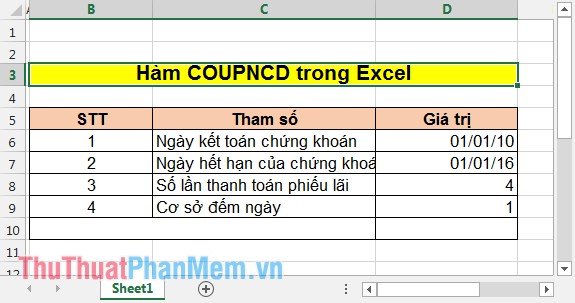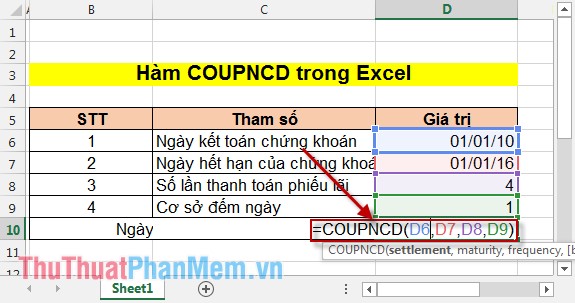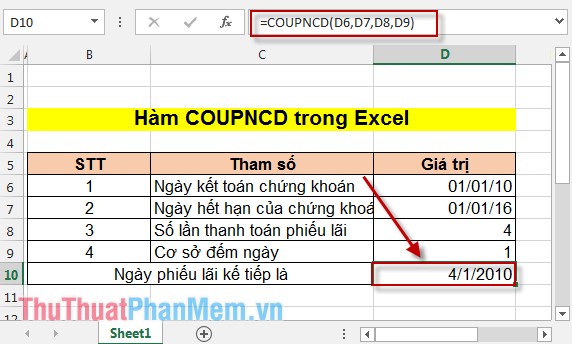COUPNCD - The function returns the next coupon date in Excel
Currently, stock investment is no stranger to people, the matter is concerned daily. Therefore, the following article introduces the COUPNCD function in detail to help you calculate the next coupon date.
Description: The function returns the next coupon date after the settlement date of the security.
Syntax: COUPNCD (settlement, maturity, frequency, [basis]) .
Inside:
- settlement : Is the date of settlement of securities (The day that securities are sold to buyers, only after issuance date), which is the required parameter.
- maturity : The maturity or maturity date of a security, which is a mandatory parameter.
- frequency : Number of coupon payments per year, a required parameter. There are values:
+ frequency = 1 => annual payment.
+ frequency = 2 => pay with a frequency of half a year.
+ frequency = 4 => payment quarterly.
- basis : The basis determined to calculate the number of days, is an arbitrary parameter. The following values are available:
+ Basis = 0 or omitted: calculate the US standard number of days of the month / days of the year is 30/360.
+ Basis = 1: the number of days in the month / days in a year is the actual number of days in the month / the number of actual days in a year.
+ Basis = 2: the number of days in the month / days in a year is the actual number of days in the month / 360.
+ Basis = 3: the number of days in a month / days in a year is the actual number of days in a month / 365.
+ Basis = 4: Based on European European standards the number of days in the month / days of the year is 30/360.
Attention:
- If the parameter value is decimal =. The function takes the value of the parameter as an integer.
- If settlement> = maturity => the function returns the #NUM! Error value.
- If basis is outside the values 0, 1, 2, 3, 4 => the error function #NUM !.
- If frequency is outside of value 1, 2, 4 => the function returns the #NUM! Error.
For example:
Calculate the next coupon date of the securities when knowing the following parameters:

In the cell to be calculated enter the following formula: = COUPNCD (D6, D7, D8, D9) .

The result has been calculated for the next coupon date:

Note: In this article, you should note that selecting the cell format returns the result of the COUPNCD function in the same date format as the securities settlement date and securities expiry date. You can use a brush to format the result cell.
Above is how to use the COUPNCD function to help you when investing in securities.
Good luck!
You should read it
- NOW function - The function returns the current date and time in Excel
- Coupdays function - Calculates the number of days in a coupon period and contains the settlement date in Excel
- DATE function - The date function in Excel
- WEEKDAY function - The function returns the weekday of a corresponding date in Excel
- YEAR - The function returns the year corresponding to a date in Excel
- TODAY function - The function returns the current date value in the format in Excel
- The WORKDAY.INTL function - The function returns a date before or after the date starting with a custom weekend in Excel
- The WORKDAY function - The function returns a date before or after the start date of a number of working days in Excel
May be interested
- COUPPCD - The function returns the previous coupon date before the settlement date in Excel
 in the previous article introduced to you the function returns the next coupon date after the settlement date. the following article introduces you to the couppcd function - the function returns the previous coupon date before the settlement date.
in the previous article introduced to you the function returns the next coupon date after the settlement date. the following article introduces you to the couppcd function - the function returns the previous coupon date before the settlement date. - CUMPRINC function - The function calculates the cumulative capital amount payable in Excel
 the following article shows how to use the cumprinc function to help you calculate by calculating the cumulative capital amount to pay.
the following article shows how to use the cumprinc function to help you calculate by calculating the cumulative capital amount to pay. - DB function - The function calculates the depreciation of assets with specific maturity in Excel
 the following article details the db function - the function of depreciation of assets with specific maturity with the use of the method of calculating the declining balance by fixed level.
the following article details the db function - the function of depreciation of assets with specific maturity with the use of the method of calculating the declining balance by fixed level. - MDURATION function - The function returns the modified term according to Macauley of stock in Excel
 mduration function - the function returns the macauley modified term of a security with an initial assumption of $ 100 in excel.
mduration function - the function returns the macauley modified term of a security with an initial assumption of $ 100 in excel. - FTEST function - The function returns the result of an F-Test in Excel
 the following article details how to use ftest - the function returns the result of an f-test. in statistical probability, the determination of the correctness and the deviation between two data samples is a regular and extremely important job.
the following article details how to use ftest - the function returns the result of an f-test. in statistical probability, the determination of the correctness and the deviation between two data samples is a regular and extremely important job. - PV function - Function that gives the current value of the investor in Excel
 the following article contains detailed instructions for the pv function to help you determine the current value of the investor.
the following article contains detailed instructions for the pv function to help you determine the current value of the investor.






 COUPPCD - The function returns the previous coupon date before the settlement date in Excel
COUPPCD - The function returns the previous coupon date before the settlement date in Excel DAY function - The function returns the date value of a specific date in Excel
DAY function - The function returns the date value of a specific date in Excel NOW function - The function returns the current date and time in Excel
NOW function - The function returns the current date and time in Excel Coupdays function - Calculates the number of days in a coupon period and contains the settlement date in Excel
Coupdays function - Calculates the number of days in a coupon period and contains the settlement date in Excel DATE function - The date function in Excel
DATE function - The date function in Excel